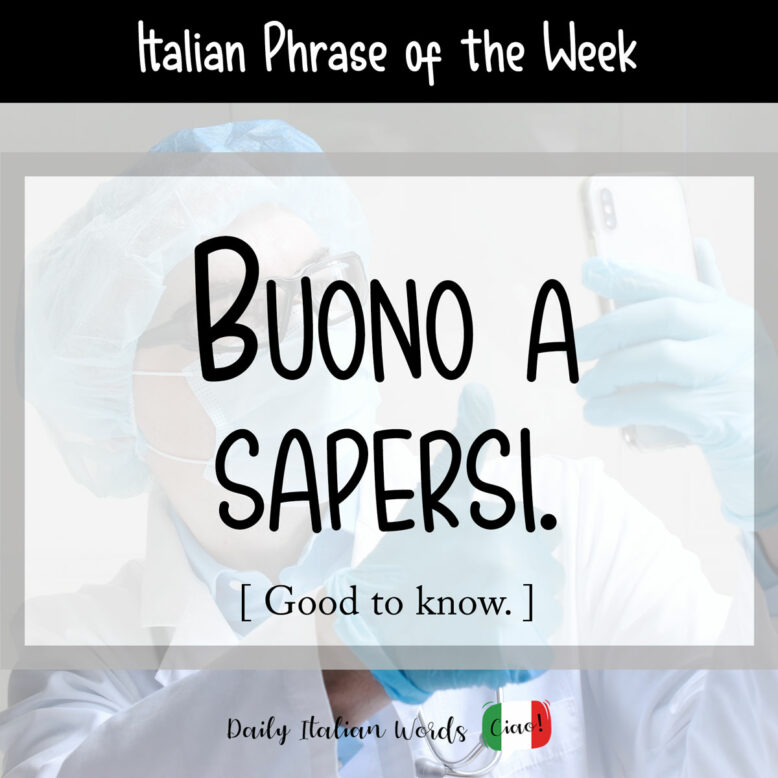When I first starting learning Italian, I remember attempting to translate the phrase “(That is) good to know!” in various ways, none of which were remotely correct. The most cringeworthy attempt was probably Bello di sapere quello! which generated quite a few laughs from my work colleagues.
So let me save you the trouble I went through during my early days of learning. The correct way to translate the idiomatic phrase Good to know! in Italian is Buono a sapersi! Let’s break it down bit by bit, shall we?
Buono a sapersi!
Good to know!

Buono is a multifaceted adjective that can mean a range of positive things including good, nice, kind, tasty, well-behaved and capable, but in this particular case, it simply means good.
Next we come to what is, for learners, the most terrifying part of this sentence, the verb sapersi. Sapersi is made up of the verb sapere (to know / to know how) and the so-called si passivante or passive si, a particle that makes the sentence both passive and impersonal.
You will see the passive si used in passive sentences featuring transitive verbs (verbs that have a direct object). The verb must be conjugated either in the third person singular or the third person plural according to the number of the object. For example:
- Qui si vende la pizza. = Pizza is sold here. (pizza is singular, so the third-person singular si vende is used)
- Qui si mangiano panini. = Sandwiches are eaten here. (panini is plural, so the third-person plural si mangiano is used)
Did you know? Two signs you will encounter a lot in Italy are vendesi and affittasi, which use the same form with the passive si. They mean for sale and for rent respectively, and as you may have already guessed, they are used to indicate houses, flats or shops that are on the market.
In addition to this, the passive si is also frequently used in constructions featuring specific adjectives (in this case buono but other common ones include bello, brutto, facile, incredibile, strano and so on) that can support an infinitive verb with a passive value introduced by the preposition a.
Here are some of the most common examples you will encounter:
- È facile a dirsi. = It’s easy enough to say.
- È più facile a dirsi che a farsi. = It’s easier said than done.
- È bello/brutto a vedersi. = It’s beautiful/ugly to look at.
Because it is passive, today’s phrase could just as easily be reworded as è buono da essere saputo (literally “it’s good to be known”), although nobody would say this in Italian.
Note: You might be tempted to use the adverb bene (which also means “good”) instead of buono but in this particular idiomatic phrase, it doesn’t work. That’s because, as an adverb, it cannot be followed by the preposition a plus an infinitive verb.

Can you use saperlo instead of sapersi?
No, not in this case. You could say È bene saperlo (literally “it is good to know”), using bene instead of buono, but there is a subtle difference in nuance. It suggests that knowing something, or how to do something, is recommended or advisable, rather than being helpful or useful in a general sense. For example:
È bene saperlo: la demenza non è una malattia che colpisce solo gli anziani.
It is good (advisable) to know: dementia isn’t a disease that only affects the elderly.
I know, it’s all a bit confusing, so my advice is to do what I did and learn it as a set idiomatic phrase without worrying too much about the grammar.
Heather Broster is a graduate with honours in linguistics from the University of Western Ontario. She is an aspiring polyglot, proficient in English and Italian, as well as Japanese, Welsh, and French to varying degrees of fluency. Originally from Toronto, Heather has resided in various countries, notably Italy for a period of six years. Her primary focus lies in the fields of language acquisition, education, and bilingual instruction.


